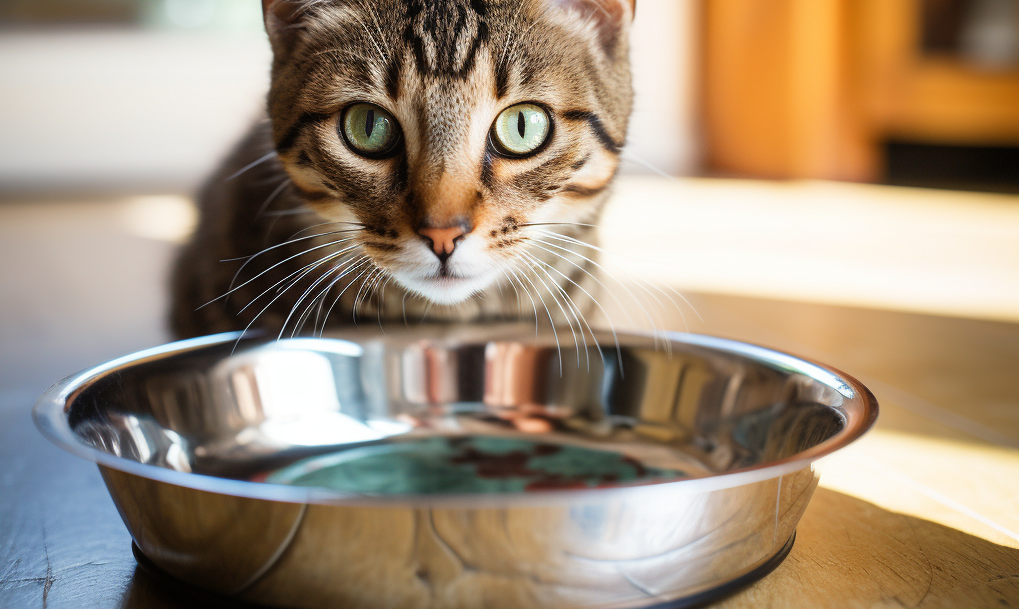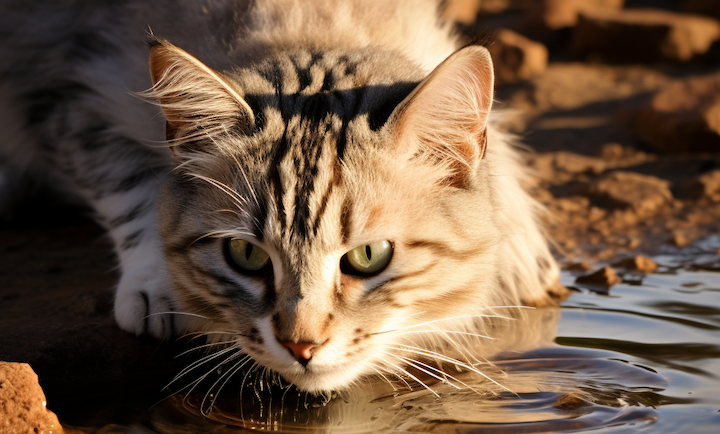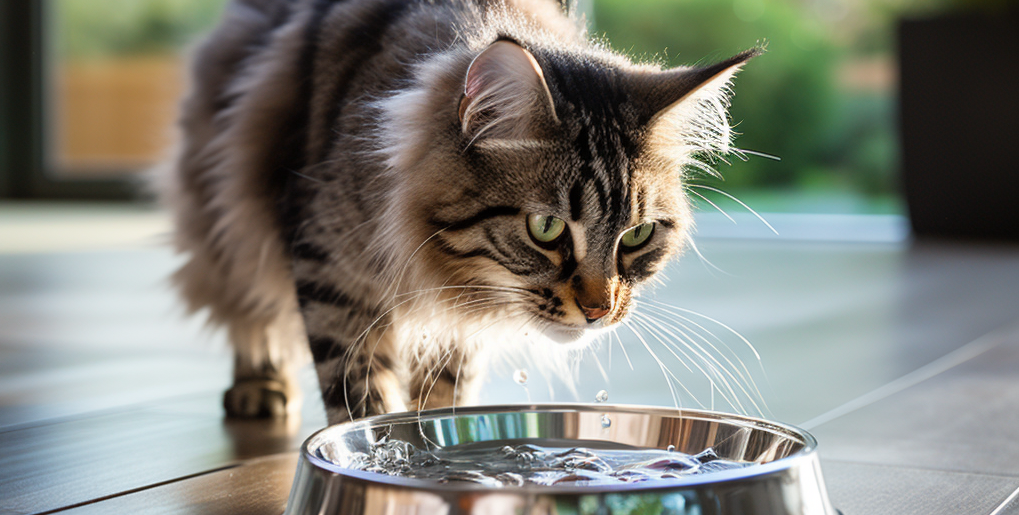Keeping Cats Hydrated: A Key to Feline Health

Hydration plays an understated yet vital role in the well-being of our feline friends. Despite their reputation for independence and resilience, cats are particularly susceptible to the risks of inadequate water intake. This article delves into the crucial aspect of cat care – hydration. Understanding the importance of water in a cat's diet is not just about quenching thirst; it's about supporting their overall health and preventing a myriad of health issues.
Cats, by nature, have a low thirst drive, a trait inherited from their desert-dwelling ancestors. This evolutionary adaptation means that cats don't always consume enough water on their own. Therefore, as responsible cat owners, it's imperative to ensure that they receive adequate hydration. Proper hydration aids in vital bodily functions in cats, including maintaining kidney health, supporting urinary tract functions, and facilitating digestion. By understanding and addressing the hydration needs of our cats, we can contribute significantly to their longevity and quality of life. In the following sections, we will explore the natural hydration habits of cats, the risks of dehydration, and practical ways to ensure that your cat stays sufficiently hydrated.
Cats' Ancestral Origins and Hydration Instincts

The key to understanding cats' hydration habits lies in their evolutionary history. Originating from arid desert regions, cats evolved as creatures adept at conserving water and obtaining moisture from their prey. This ancestral survival strategy profoundly influences their contemporary behavior and physiology. Unlike humans or dogs, who have a more pronounced instinct to drink water, cats have retained their forebears' low thirst drive. This trait was advantageous in their natural habitat, where water sources were scarce and their primary hydration source was the moisture content in their prey, typically small rodents or birds.
Today's domestic cats, however, often have diets that differ significantly from those of their wild ancestors. While their natural diet would be high in moisture, many modern cat foods, especially dry kibble, do not provide the same level of hydration. This mismatch can lead to cats not naturally seeking out enough water to compensate, thereby increasing the risk of dehydration. Understanding this disconnect between their natural hydration habits and their current dietary patterns is crucial for cat owners. It underscores the importance of either incorporating moisture-rich foods into their diet or finding creative ways to encourage more frequent water intake.
The Hidden Dangers of Feline Dehydration
Dehydration in cats, often a subtle yet serious issue, can lead to significant health complications if not addressed promptly. Recognizing the signs of dehydration is crucial for cat owners. Some key indicators include lethargy, dry mouth, sunken eyes, and a loss of skin elasticity (which can be tested by gently pinching the skin on the back of the neck - if it doesn't quickly return to normal, it could be a sign of dehydration). Additionally, decreased appetite and reduced urination can be warning signs.
The health risks associated with chronic dehydration in cats are manifold and can have long-term consequences. One of the most critical concerns is the development of kidney disease, a common ailment in cats. Adequate hydration is essential for kidney function, helping to flush out toxins and maintain healthy kidney tissue. Furthermore, insufficient water intake can lead to urinary tract issues, including urinary tract infections (UTIs) and the formation of urinary crystals or stones, which can be extremely painful and require immediate veterinary attention.
Chronic dehydration can also impact a cat’s overall vitality, leading to digestive problems and a weakened immune system. Understanding these risks underscores the importance of monitoring your cat's water intake and ensuring they remain well-hydrated, which is integral to their overall health and wellbeing.
Key Factors Leading to Dehydration in Cats
Cats are naturally predisposed to drink less due to their desert-origin genes, which give them a lower thirst drive compared to dogs. Their vision may make it difficult to see water's edge in a bowl. When they drink, their tongue forms a 'J' shape, capturing only a tiny amount of water (about 3/100 of a teaspoon per lap), making their drinking method somewhat inefficient. Cats also prefer fresh, moving water over stagnant. Additionally, health issues like chronic kidney disease, diabetes, or conditions causing diarrhea can increase their risk of dehydration.
Enhancing Feline Health Through Hydration
Proper hydration is a cornerstone of maintaining optimal health in cats. When cats are adequately hydrated, their bodies function at their best, leading to numerous health benefits. One of the most significant advantages of proper hydration is the support it provides to kidney function. The kidneys, vital organs in filtering and removing waste products from the blood, require sufficient water to operate efficiently. Adequate hydration helps in diluting the urine, reducing the risk of kidney stones and helping to prevent kidney disease, a common issue in felines.
Beyond kidney health, proper hydration is essential for maintaining a healthy digestive system. Sufficient water intake aids in the smooth passage of food through the gastrointestinal tract, preventing constipation and helping the body absorb nutrients effectively. This results in better overall digestion and can contribute to a healthier, more active cat.
Furthermore, hydration plays a crucial role in urinary health. Cats with a well-hydrated system are less likely to develop urinary tract infections and other urinary disorders. Adequate water intake ensures that the urinary tract is continuously flushed out, reducing the chance of crystal formation and infection.
In summary, ensuring your cat stays properly hydrated is not just about quenching thirst—it's about supporting their kidney function, digestion, and urinary health, contributing to a happier, healthier life for your feline companion.

Effective Strategies for Keeping Your Cat Hydrated
Ensuring your cat stays adequately hydrated is crucial for their health, but it can sometimes be a challenge. Here are some practical tips to encourage more water intake and innovative hydration solutions.
- Multiple Water Stations: Cats may be more inclined to drink water if it's easily accessible. Place several water bowls around your home, especially in areas where your cat spends a lot of time. This increases the chances of them taking a sip more often.
- Fresh, Clean Water: Cats prefer fresh water, so it’s important to change it daily or even several times a day. Also, keeping the bowl clean is essential as cats have a heightened sense of taste and smell.
- The Role of Wet Food: Incorporating wet food into your cat’s diet is an excellent way to increase their water intake. Wet food can contain up to 80% water, significantly contributing to their daily hydration needs. It's especially beneficial for cats that naturally consume little water.
- Cat Water Fountains: Many cats prefer running water as it’s a throwback to their instinctual preference for fresh, clean water sources. Cat water fountains are great for enticing cats to drink more due to the movement and filtration system that keeps the water fresh.
- Flavoring Water: Occasionally adding a bit of flavor to the water, such as a small amount of low-sodium chicken broth, can make it more appealing to some cats.
- Ice Cubes or Water Toys: Some cats enjoy playing with ice cubes or special floating toys in their water bowls, which can also encourage them to drink more.
By implementing these strategies, cat owners can significantly improve their pets' water consumption. Remember, each cat is unique, so it may take some experimentation to find out what works best for your feline friend.
Identifying Proper Hydration in Cats
Recognizing if a cat is properly hydrated is key to their health. A well-hydrated cat will have moist, pink gums, and their skin will show good elasticity. This can be tested by gently lifting the skin on the back of the neck; it should spring back quickly when released. Another indicator is clear, dilute urine. Regular veterinary check-ups are crucial, as vets can provide a more detailed assessment of hydration levels and overall health. These check-ups also help catch any potential health issues early, ensuring your cat remains healthy and well-hydrated.
How Much Water Should a cat Drink?
The amount of water a cat should consume daily varies based on several factors, including their weight, diet, age, and activity level. As a general guideline:
- A cat should drink approximately 3.5 to 4.5 ounces of water per 5 pounds of body weight each day.
This means that for a 10-pound cat, the daily water intake should be about 7 to 9 ounces. However, this can vary depending on the cat's diet:
- Dry Food Diets: Cats on dry food diets may require more water, as dry kibble contains less moisture compared to wet food.
- Wet Food Diets: Cats consuming wet or canned food, which typically contains about 70-80% water, may require less additional water.
It's also important to remember that cats' water needs can change with the weather, their health status, and their activity levels. Always ensure fresh, clean water is available for your cat, and monitor their drinking habits for any significant changes that could indicate health issues.
Hydration: A Vital Aspect of Feline Health
In conclusion, proper hydration is pivotal for a cat's health, affecting everything from kidney function to digestion and urinary health. Ensuring that your cat consumes enough water, whether through their diet or other innovative methods like cat fountains, is essential. Recognizing both the signs of dehydration and adequate hydration helps in maintaining their well-being. Regular veterinary check-ups further support this goal. Remember, a well-hydrated cat is a healthier, happier cat. By prioritizing hydration, cat owners can make a significant difference in the quality of life and longevity of their feline companions.
Frequently Asked Questions:
How much water should a cat drink daily?
On average, a cat should drink approximately 3.5–4.5 ounces of water per 5 pounds of body weight daily. However, this can vary depending on their diet, activity level, and environmental conditions.
Can cats get enough water from dry food alone?
Dry food alone may not provide sufficient hydration. It's recommended to supplement with wet food or ensure ample fresh water is available.
Are there any signs of overhydration in cats?
Overhydration is rare but can occur. Signs include restlessness, bloating, vomiting, and lethargy. If you suspect overhydration, consult your vet immediately.
How can I tell if my cat dislikes their water?
Signs include avoiding the water bowl, drinking less than usual, or showing interest only when the water is fresh. Experiment with different bowls or locations to encourage drinking.
Is tap water safe for cats, or should I use filtered water?
Most tap water is safe, but if you're concerned about quality, filtered or bottled water is a good alternative. However, avoid giving distilled water as it lacks essential minerals.
How often should I change my cat's water?
Change the water at least once daily, and ensure the bowl is clean to encourage drinking.
Can certain foods help with hydration?
Yes, wet foods are particularly beneficial for hydration due to their high moisture content.